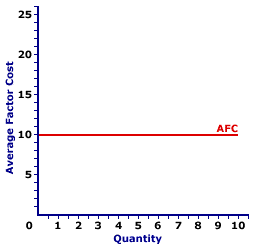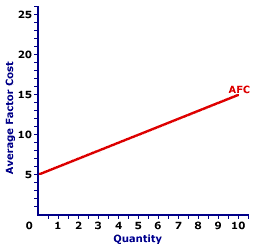
|
|
CHAIRMAN OF THE BOARD OF GOVERNORS: The head of the Federal Reserve Board of Governors and the Federal Reserve System. This is the guy in charge of monetary policy and is considered to be one of the two or three most powerful people in terms of the national and global economy. The Chairman is one of the seven members of the Board and serves as Chairman for a five-year term. The Fed Chairman also serves as Chairman of the powerful Federal Open Market Committee, the Fed Committee that sets the course of monetary policy.
Visit the GLOSS*arama
|
|


|

|
                           AVERAGE FACTOR COST CURVE: A curve that graphically represents the relation between average factor cost incurred by a firm for employing an input and the quantity of input used. Because average factor cost is essentially the price of the input, the average factor cost curve is also the supply curve for the input. The average factor cost curve for a firm with no market control is horizontal. The average revenue curve for a firm with market control is positively sloped. An average factor cost curve is the relation between the average factor cost a firm incurs from using a factor input and the quantity of input employed. The average factor cost curve reflects the degree of market control held by a firm. For a perfectly competitive firm with no market control, the average factor cost curve is a horizontal line. For firms with market control, especially monopsony, the average factor cost curve is positively sloped.Perfect CompetitionPerfect competition is a market structure with a large number of small participants (buyers and sellers). The good exchanged in the market is identical, regardless of who sells or who buys. Participants have perfect knowledge and perfect mobility into and out of the market. These conditions mean perfectly competitive buyers are price takers, they have no market control and must pay the going market price for all inputs bought.Average Factor Cost Curve,
Perfect Competition |  |
A typical average factor cost for perfect competition is displayed in the exhibit to the right. This particular average factor cost curve is that for labor hired by Maggie's Macrame Shoppe. Maggie's Macrame Shoppe is one of thousands of small retail stores in the greater Shady Valley metropolitan area that hires labor with identical skills. As such, Maggie pays the going wage for labor.The vertical axis measures average factor cost and the horizontal axis measures the quantity of input (workers). Although quantity on this particular graph stops at 10 workers, the nature of perfect competition indicates it could easily go higher. First and foremost, the average factor cost curve is horizontal at the going factor price of $10. This indicates that if Maggie hires 1 worker, then she pays an average factor cost of $10. Alternatively, if she hires 10 workers, then she pays an average factor cost of $10 per worker. Should she hire 100 workers, then she might move well beyond the graph, but she pays an average factor cost of $10 per worker. The "curve" is actually a "straight line" because Maggie is a price taker in the labor market. She pays $10 for each worker whether she hires 1 worker or 10 workers or 100 workers. The constant price is what makes Maggie's average factor cost curve a straight line, and which indicates that Maggie has no market control. Monopsony, Oligopsony, and Monopsonistic CompetitionFor market structures like monopsony, oligopsony, and monopsonistic competition that have some degree of market control on the buying-side of the market and are price makers rather than price takers, average factor cost is little different. Market control means these market structures face positively-sloped supply curves. As such, the price paid is not fixed, but depends on the quantity of the good bought.Average Factor Cost Curve,
Monopsony |  |
The exhibit to the right displays the average factor cost curve for another hypothetical firm, OmniKing Island Resort. This firm is the only employer of labor on a small tropical island. As the only employer of labor on the Island, OmniKing is a monopsony with extensive market control, and it faces a positively-sloped supply curve. To employ more workers, OmniKing must pay a higher price.The vertical axis measures average factor cost and the horizontal axis measures the quantity of input (workers). Although quantity on this particular graph stops at 10 workers, it could go higher. This curve indicates that if OmniKing hires 1 worker (at $6 per worker), then it incurs $6 of average factor cost. Alternatively, if it hires 10 workers (at $15 per worker), then it pays $15 of average factor cost. This positively-sloped average factor cost curve is actually nothing more than the supply curve facing OmniKing for hiring labor. In the analysis of factor markets, the average factor cost curve and the supply curve facing the firm are almost always one and the same. Although this average factor cost curve, and preceding table of average factor cost numbers, is based on the employment activity of OmniKing Island Resort, a well-known monopsony firm, they apply to any buyer with market control. Monopsonistic competition and oligopsony firms that also face positively-sloped supply curves generate comparable average factor costs.

Recommended Citation:AVERAGE FACTOR COST CURVE, AmosWEB Encyclonomic WEB*pedia, http://www.AmosWEB.com, AmosWEB LLC, 2000-2025. [Accessed: July 18, 2025].
Check Out These Related Terms... | | | | | | | | | | |
Or For A Little Background... | | | | | | | | | | | |
And For Further Study... | | | | | | | | |
Search Again?
Back to the WEB*pedia
|



|

|
YELLOW CHIPPEROON
[What's This?]
Today, you are likely to spend a great deal of time searching the newspaper want ads trying to buy either a T-shirt commemorating the 2000 Olympics or a genuine fake plastic Tiffany lamp. Be on the lookout for telephone calls from former employers.
Your Complete Scope
This isn't me! What am I?
|

|
|
General Electric is the only stock from the original 1896 Dow Jones Industrial Average remaining in the current index.
|

|
|
"A winner is someone who recognizes his God-given talents, works his tail off to develop them into skills, and uses those skills to accomplish his goals. " -- Larry Bird, basketball player
|

|
NNP
Net National Product
|

|
|
Tell us what you think about AmosWEB. Like what you see? Have suggestions for improvements? Let us know. Click the User Feedback link.
User Feedback
|


|


